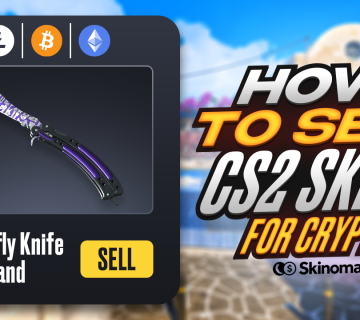Steam trading is a very popular and lucrative niche, and gamers are actively selling their Steam items on various online platforms, very often for huge sums of money. This makes their items a ripe target for hackers and scammers. Common Steam scams are prevalent, and it is essential to remain vigilant to avoid falling victim to these tricks. Whether you’re looking to sell CS2 (CS:GO) skins, Dota 2 items, Rust skins, or TF2 items, a single successful scam can cost your Steam account thousands of dollars.
As scammers continuously refine their tactics, staying informed about the latest Steam trading scams is essential for protecting your valuable items. This article will provide comprehensive insights into safely selling Steam items while avoiding common traps and scams. Learning about these traps in detail will help you sell Steam items safely, without having to worry about losing your money.
Common Steam Scams
Navigating the Steam trade market requires awareness of various scam techniques. Here’s a deep dive into the most common scams you’ll encounter, each posing unique challenges and threats to unsuspecting traders:
One prevalent scam is the ‘accidentally reported’ scam, where scammers falsely claim that their target has been reported for scamming or illegal activities. These fraudsters often pose as friends or acquaintances on Steam, instilling fear in the victim by suggesting the need to contact a supposed Steam representative for assistance, which ultimately leads to attempts at soliciting gift card payments under the pretense of resolving the issue. Another tactic involves fake admins requesting users to log out to ‘start the scanning of your account status,’ manipulating victims’ fears about their account condition.
Want to conduct safe transactions? Check out our TF2 trading guide!
1. Phishing Scams
Phishing scams are deceptive tactics where scammers send links pretending to be official trading websites or Steam partner sites. In fact, phishing attempts are also popular outside of Steam and are one of the most common hacker attack methods carried out by scammers worldwide. An efficient phishing scam can bypass some of the best security measures, making it particularly dangerous.
These phishing websites look authentic, tricking users into inputting their Steam credentials. Scammers can then easily gain access to the Steam fake login pages. Once scammers have your login details, they can gain access to your account and valuable items.
Phishing attacks are a crucial part of most scams on this list, as the hackers must first gain access to your account in order to steal items from you. Once the scammers are in possession of your sensitive information, they can break into your account and trade items into their own account. Also, if the hackers gain access to your account, they can further compromise any payment cards connected to it, not only causing you to lose Steam items, but often money from your bank account as well.
Here’s an example of a phishing scam in action:
2. Steam API Scam
API scams exploit Steam’s API key feature, typically used by legitimate developers. This particular scam uses a security exploit in the Steam code and is often carried out after a successful phishing scam. Each Steam user has a unique API key connected to their account, which is used to facilitate trades when you sell Steam items. If you frequently conduct transactions and, for example, sell Rust skins, you’re a prime target for an API scam.
Scammers trick users into providing their API keys through deceptive sites or fake services. With an API key, scammers can intercept and reroute trade offers, siphoning your valuable items. Once the scammers get a hold of your API key, they can use it to control trade offers sent to your account. The most common tactic is to wait until you get a trade request for a rare and expensive CS2 skin, and immediately cancel the trade. The scammer then immediately sends a new request from a dummy account, made to look legitimate, hoping you’ll trade your game items to them, instead of the legitimate user. This way you might sell Dota 2 items from your account to a fake scammer account.
API scams are some of the most popular methods of stealing Steam items from users, and many players often accept the second trade, believing that the legitimate trader has accidentally closed the window and is trying to connect to them again. Unlike other scams, these ones are particularly nefarious, and it’s often difficult to recover stolen items.
In the video below you can learn everything there’s to know about Steam API scams:
3. Discord Scams
Discord ranks among the most popular chat services, with a vast majority of gamers having the Discord app installed on their computers. Designed specifically for gamers to facilitate easy and convenient voice communication, Discord has rapidly ascended in popularity, becoming one of the world’s most widely used messaging apps. Its widespread use has attracted a multitude of traders who organize and conduct trades via dedicated Discord channels, which has also, unfortunately, attracted numerous scammers.
Discord scams are incredibly prevalent and quite dangerous, mainly because the scammers contact you personally, making their attempts appear very genuine and realistic. Typically, these scams involve scammers working in pairs or larger groups, similar to many banking scams, with one scammer impersonating a Steam support member. Other times, you might get a message from another Discord user, offering to sell TF2 items for surprisingly low prices.
The specifics of each Discord scam can vary significantly. For instance, scammers may send a link to a fake website designed to phish your Steam credentials and possibly infect your computer with malware. Another common tactic involves a scammer reaching out to claim they accidentally reported your account, then redirecting you to another scammer posing as Steam support. Scammers also frequently message about fake giveaways in trading Discords, falsely claiming you have a chance to win free Steam items. In all instances, the ultimate aim is to deceive the victim into revealing sensitive information or making trades that result in losing valuable Steam items.
Here are some examples of common Discord scams:
Got some rare knives you want to trade away? Check out Skinomat CS2 knife trading guide!
4. Item Switch Scams
The item switch scam is arguably the simplest scamming technique in existence, and many players assume they’re immune to falling for such a basic trick. Unfortunately, this assumption is precisely why so many individuals end up as victims.
This straightforward tactic involves the scammer substituting items moments before the trade is completed. For instance, you might agree to exchange your AWP Dragon Lore for an expensive CS2 knife, but just before you accept and finalize the transaction, the other trader removes their item and substitutes it with one of the cheapest CS2 skins available. If you don’t pay close attention to the screen, you could inadvertently confirm the trade, resulting in the loss of your valuable item.
5. SSFN File Scam
This method exploits the SSFN file system, which plays a crucial role in Steam’s two-factor authentication process. While this technique isn’t as commonly used today, understanding the risks associated with sharing your SSFN file data remains critical.
Similar to other scams mentioned, the SSFN file scam initially requires a successful phishing attempt, allowing scammers to acquire your SSFN file data. Essentially, the SSFN file records information from your two-factor authentication process on Steam. This file acts as a confirmation that it’s genuinely you logging in, so you don’t have to repeat the authentication process every time you access Steam on your computer. However, once scammers obtain your SSFN file, they can use it to circumvent the two-factor authentication on your Steam account, effectively breaching Steam’s security measures.
This method allows the hackers to gain access to your account without you noticing, giving them a near-complete control. Most players are only aware that a scam has taken place after they notice all of their items compromised and gone, after which it’s very difficult to get help and your Steam items back.
Check out this video to learn more about the dangers of SSFN scams:
Tips to Sell Steam Items Safely
Selling your Steam items can be rewarding, but it requires caution and savvy to avoid pitfalls. Here are some critical tips to ensure a secure trading experience while maximizing the value and safety of your items:
- Use Reliable Sites
- Choose well-established trading platforms known for their security measures and positive user feedback. Trusted sites like Skinomat provide a secure environment for both buyers and sellers. Selecting reputable platforms minimizes the risk of falling victim to scams, ensuring safe and smooth transactions. Reliable sites have robust security protocols in place, including encrypted transactions and comprehensive verification processes for traders. Moreover, these platforms often have dedicated support teams to assist with any trading issues, thereby enhancing user trust and satisfaction. Utilizing platforms with strong community endorsements and proven security measures is your best bet for safe trading.
- Verify Trade Offers
- Always take the time to verify the details of each trade offer. Ensure the items match what was agreed upon in terms of quality, quantity, and condition. Scammers often insert less valuable items into trade offers, relying on rushed trades. Double-check every aspect of the trade, and if anything appears off, it’s best to decline and reassess the situation. Verification extends beyond simply comparing items; it involves scrutinizing trade timestamps, item histories, and any notes accompanying the trade. By thoroughly validating each component, you minimize the risk of falling prey to deceptive trades. Additionally, consider utilizing trade verification tools or extensions that highlight any discrepancies in real-time, offering an added layer of security.
- Enable Steam Guard
- Enabling Steam Guard’s two-factor authentication is crucial for securing your account. This added layer of security requires a verification code from your email or mobile device, significantly reducing the chance of unauthorized access. Steam Guard acts as a vital safeguard, protecting your assets from potential intruders. Incorporating Steam Guard best practices, such as frequently updating your email credentials and monitoring login attempts, further bolsters your account security. By maintaining vigilance and promptly responding to any unusual activities, you ensure your personal and account information remains secure from unauthorized access.
- Beware of Deals That Are Too Good to Be True
- Remember, if a deal looks too good to be true, it probably is. Scammers entice victims with high-value trades at irresistibly low prices. Approach these offers with skepticism, ensuring you perform due diligence to verify their legitimacy before proceeding. Taking the time to research and evaluate such deals protects you from fraudulent schemes. Scammers often employ psychological tactics, such as creating a sense of urgency to compel hasty decisions. By remaining composed and diligently researching the deal, including verifying the trader’s reputation and cross-referencing item values, you can protect yourself from being swindled. Utilizing market monitoring tools and price comparison platforms can also aid in assessing the veracity of trade offers.
- Research the Platform
- Before using a new trading platform, thoroughly research its reviews and user feedback. Look for signs of complaints or scam reports associated with the site. Platforms like Skinomat, with positive reviews and strong community endorsements, stand out as reliable options. A background check can prevent potential fraud and secure your valuable items. Comprehensive research involves diving into forums, reading detailed reviews, and checking the platform’s history of handling disputes. By accumulating a broad spectrum of insights, you ensure the platform’s legitimacy and reliability. Engaging with community feedback and expert reviews can further validate your platform choice, ensuring a secure trading environment.
- Protect Your Steam Gift Cards
- Steam gift cards are a popular target for scammers due to their ease of processing and anonymity. Always purchase gift cards from reputable sources and avoid sharing card details with anyone. Be cautious of phishing schemes that attempt to steal your gift card information. Steam users should be aware of various scams targeting their accounts and take proactive measures to protect themselves.
Final Thoughts
Selling Steam items like CS2 (CS:GO) skins, Dota 2 items, Rust skins, or TF2 items can be profitable. By using reputable platforms like Skinomat, maintaining strong security measures, and staying alert to common scam tactics, you can enjoy a secure and successful trading experience. Stay safe and happy trading!




No comment